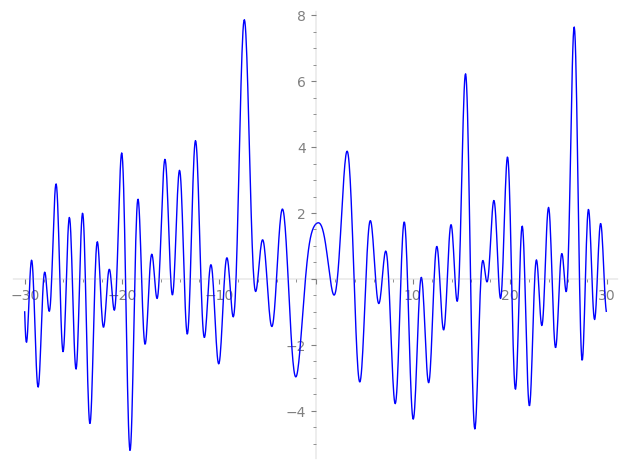| L(s) = 1 | + (−0.690 + 1.58i)3-s + (1.99 − 1.00i)5-s + (1.11 + 0.644i)7-s + (−2.04 − 2.19i)9-s + (2.54 − 4.41i)11-s + (3.09 − 1.78i)13-s + (0.225 + 3.86i)15-s − 0.895i·17-s − 5.34·19-s + (−1.79 + 1.32i)21-s + (4.38 − 2.53i)23-s + (2.96 − 4.02i)25-s + (4.89 − 1.73i)27-s + (−1.5 + 2.59i)29-s + (−3.29 − 5.71i)31-s + ⋯ |
| L(s) = 1 | + (−0.398 + 0.917i)3-s + (0.892 − 0.451i)5-s + (0.421 + 0.243i)7-s + (−0.682 − 0.731i)9-s + (0.767 − 1.32i)11-s + (0.857 − 0.495i)13-s + (0.0582 + 0.998i)15-s − 0.217i·17-s − 1.22·19-s + (−0.391 + 0.289i)21-s + (0.914 − 0.528i)23-s + (0.592 − 0.805i)25-s + (0.942 − 0.334i)27-s + (−0.278 + 0.482i)29-s + (−0.592 − 1.02i)31-s + ⋯ |
Λ(s)=(=(720s/2ΓC(s)L(s)(0.999+0.00269i)Λ(2−s)
Λ(s)=(=(720s/2ΓC(s+1/2)L(s)(0.999+0.00269i)Λ(1−s)
| Degree: |
2 |
| Conductor: |
720
= 24⋅32⋅5
|
| Sign: |
0.999+0.00269i
|
| Analytic conductor: |
5.74922 |
| Root analytic conductor: |
2.39775 |
| Motivic weight: |
1 |
| Rational: |
no |
| Arithmetic: |
yes |
| Character: |
χ720(529,⋅)
|
| Primitive: |
yes
|
| Self-dual: |
no
|
| Analytic rank: |
0
|
| Selberg data: |
(2, 720, ( :1/2), 0.999+0.00269i)
|
Particular Values
| L(1) |
≈ |
1.66214−0.00223641i |
| L(21) |
≈ |
1.66214−0.00223641i |
| L(23) |
|
not available |
| L(1) |
|
not available |
L(s)=p∏Fp(p−s)−1 | p | Fp(T) |
|---|
| bad | 2 | 1 |
| 3 | 1+(0.690−1.58i)T |
| 5 | 1+(−1.99+1.00i)T |
| good | 7 | 1+(−1.11−0.644i)T+(3.5+6.06i)T2 |
| 11 | 1+(−2.54+4.41i)T+(−5.5−9.52i)T2 |
| 13 | 1+(−3.09+1.78i)T+(6.5−11.2i)T2 |
| 17 | 1+0.895iT−17T2 |
| 19 | 1+5.34T+19T2 |
| 23 | 1+(−4.38+2.53i)T+(11.5−19.9i)T2 |
| 29 | 1+(1.5−2.59i)T+(−14.5−25.1i)T2 |
| 31 | 1+(3.29+5.71i)T+(−15.5+26.8i)T2 |
| 37 | 1−7.24iT−37T2 |
| 41 | 1+(−3.92−6.79i)T+(−20.5+35.5i)T2 |
| 43 | 1+(−9.46−5.46i)T+(21.5+37.2i)T2 |
| 47 | 1+(2.57+1.48i)T+(23.5+40.7i)T2 |
| 53 | 1−4.78iT−53T2 |
| 59 | 1+(−2.87−4.98i)T+(−29.5+51.0i)T2 |
| 61 | 1+(2.17−3.75i)T+(−30.5−52.8i)T2 |
| 67 | 1+(7.39−4.26i)T+(33.5−58.0i)T2 |
| 71 | 1−5.34T+71T2 |
| 73 | 1+9.34iT−73T2 |
| 79 | 1+(−0.370+0.642i)T+(−39.5−68.4i)T2 |
| 83 | 1+(−7.97−4.60i)T+(41.5+71.8i)T2 |
| 89 | 1−9.24T+89T2 |
| 97 | 1+(2.99+1.72i)T+(48.5+84.0i)T2 |
| show more | |
| show less | |
L(s)=p∏ j=1∏2(1−αj,pp−s)−1
Imaginary part of the first few zeros on the critical line
−10.60288156660340871400052828521, −9.409499135803636294353086448481, −8.882280454155641348565540672193, −8.215554280954697575376804813020, −6.38027138103629406251118231237, −5.97128872463973113769005550388, −5.02789341729405913181015122514, −4.04470122441978125938517679346, −2.84220814642831326813051124062, −1.06003824912197139798975400825,
1.49584832387724757488527027396, 2.22785596311731643663686944464, 3.95253112106624186099734866204, 5.17296551637279303611454337854, 6.17432817085334799244763027898, 6.85362400463265829143770530992, 7.51420063041616895568229391148, 8.778533194788781528604197157783, 9.458689460983131189282003172811, 10.82331855264020598605257325809

